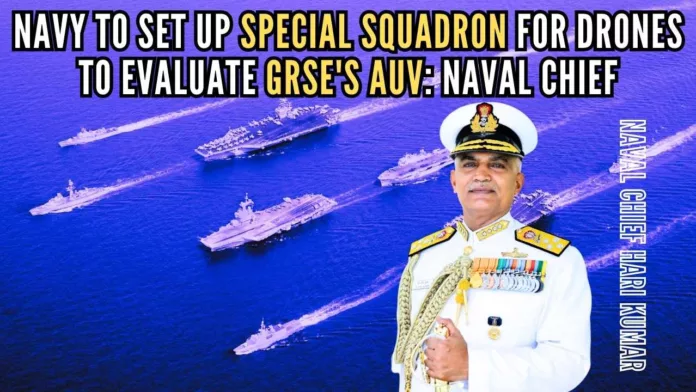
The fourth frigate being built by MDL will be launched in a few weeks from now: Naval Chief Hari Kumar
The Indian Navy is in the process of setting up a special Remotely Piloted Squadron for aerial, surface, and sub-surface drones, Chief of Naval Staff (CNS) Admiral R Hari Kumar said.
The Navy is already in the process of evaluating several autonomous platforms, including an Autonomous Underwater Vehicle (AUV) launched by Garden Reach Shipbuilders and Engineers (GRSE) Ltd a few days ago, he added.
“The character of war changes. We have all seen how drones are being effectively used in the Russia-Ukraine war. The Indian Navy is already using a variety of Unmanned Aerial Vehicles (UAVs). We are now trying out the Autonomous Surface Vessel (ASV) developed by Goa Shipyard Ltd and there is the AUV launched by GRSE of course,” Admiral Kumar said.
The Naval chief was in Kolkata for the launch of the third and last of the three Indian Navy’s Project 17A Advanced Stealth Guided Missile Frigates that were assigned to GRSE.
Four more are being built by Mazgaon Dockyard Limited (MDL).
According to the Naval chief, the fourth frigate being built by MDL will be launched in a few weeks from now.
Admiral Kumar expressed hope that all seven frigates will be delivered on time.
These frigates will be armed with Brahmos missiles and have the latest MF-STAR antennae. They will also have long-range surface-to-air missiles to counter any aerial threat.
Launching of a warship is an important part of the overall shipbuilding process. This is when the hull and superstructure of the ship is built and it gets ready to float.
This is when the ship is named and tastes water under her keel for the first time.
On Thursday, President Droupadi Murmu launched the ship and named her INS Vindhyagiri.
She commended the efforts by GRSE to achieve self-reliance in the field of shipbuilding.
The President also recounted her visits to Visakhapatnam and onboard India’s Indigenous Aircraft Carrier (IAC) INS Vikrant.
She was full of praise for GRSE for its efforts towards ‘Aatmanirbharta‘ or self-reliance.
Admiral Kumar said during his address that the Indian Navy will be investing thousands of crores to acquire modern warships.
Of the 63 platforms on order, 61 are being built by Indian shipyards.
He also reiterated the Navy’s commitment to achieve 100 percent indigenization in shipbuilding by 2047.
President Murmu spoke on India’s aspirations towards becoming the third-largest economy in the world.
She spoke on how a strong Navy is important to ensure India’s economic growth.
She was keen on Aatmanirbharta and the efforts being made by defence establishments like GRSE.
GRSE chairman and managing director Cmde P R Hari IN (Retd) called Thursday’s launch the ‘Mother of all Ship Launches‘ as INS Vindhyagiri was the first warship till date to be launched by the President who is also the Supreme Commander of the Indian Armed Forces.
Cmde Hari also called GRSE mature, modern, and future-ready to meet all needs of the Indian Navy.
Admiral Kumar appreciated GRSE’s efforts and said: “Navies can’t be bought. They have to be built. We have already made it clear that the Indian Navy will achieve 100 percent Aatmanirbharta by 2047. Any warship has three facets. It has to float, it has to move and it has to fight.
“We have already achieved 95 percent indigenization in the floating part and 65-70 percent in the area of movement. In the next 5-7 years, we shall be self-sufficient in this aspect as we are already building engines and other components.
“In the fighting aspect, we have achieved about 55 percent indigenization. We are now looking at the latest equipment being developed by Indian companies.”
[With Inputs from IANS]
PGurus is now on Telegram. Click here to join our channel and stay updated with all the latest news and views
For all the latest updates, download PGurus App.
- Myanmar authorities seize 100 Kg methamphetamine, 13 kg of ketamine in southern region - April 28, 2024
- Centre permits export of 99,150 tonnes of onion to 6 countries - April 28, 2024
- Delhi Congress chief resigns, cites party’s alliance with AAP - April 28, 2024








